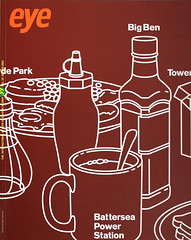Spring 2001
You can judge a cover by its book
Has Penguin lost its touch? Though its original identity came from pairing strong images with a shrewd choice of fiction, the latest round of designs smells like empty marketing. Critique by Rick Poynor
For readers of a certain generation, the Penguin Modern Classics were a literary education. The uniform cover designs with the pale green spines were a guarantee that if you enjoyed one book, here were dozens of others of similar richness and quality. The cover images, often chosen with superb sensitivity to atmosphere, were a visual education in themselves. Today, we would call this ‘branding’. Over time, though, Penguin lost ground. Many fresh, imaginative competitors arrived on the scene, some of the same classics were available elsewhere, and the formulaic covers started to look unnecessarily rigid and dull. If readers with the Penguin habit were drifting away, how many younger book buyers were signing up?
In October 1998, the firm initiated a belated attempt to seduce the under-25s away from CDs and computer games. For the striking new Penguin Essentials covers, devised by some of Britain’s most fashionable designers – Intro, Tomato, Angus Hyland, Chris Ashworth and Amanda Sissons, Yacht Associates – there would be no set format. ‘In the past, we’ve been guilty of staying on safe ground,’ Penguin art director John Hamilton told The Face. ‘But this is such an obvious marketing idea, I can’t think why it hasn’t been done before.’ Because this was Penguin and because of the designers, the books were widely noticed and, in some quarters, rapturously received.
In truth, the covers for Kerouac’s On the Road, Capote’s In Cold Blood, Burgess’s A Clockwork Orange, Orwell’s Down and Out in Paris and London and other classics were a mixed bunch. Nor were they especially different from many other imprints’ covers, despite bullish claims by one designer that publishing suffered from a pervasive ‘K-Tel mentality’. Looking back, the more modish Essentials provide a snapshot of 1990s graphic taste: broken, wonkily placed letterforms; blurred and grainy image fragments (preferably indeterminate); an over-optimistic belief that a type treatment alone can serve to evoke an imaginary world. They were often attractive objects, but some displayed a distinctly shaky grasp of the mood of these mainly fictional works, and this, let’s not forget, was once the area in which Penguin excelled (see Germano Facetti, ‘The Image as Evidence’, Eye no. 29 vol. 8).
Eleven more Essentials have now appeared and Penguin’s touch seems, if anything, to be even less certain. When it was originally published by them in 1990, cult rock star Nick Cave’s twisted Gothic parable And the Ass Saw the Angel employed a haunting photograph by Julia Margaret Cameron of an angelic child, printed with metallic ink. The new version by someone called Banksy is a graffiti-sprayed wall, with coarse stencil lettering, that has nothing very obvious to do with Cave’s American Deep South. Isabel Allende’s Eva Luna is decorated with amorphous blobs that convey nothing at all. There is visual evidence at Penguin’s website that they originally planned to symbolise the ten New England couples in John Updike’s Couples as a series of paired coloured dots. Hardly a stroke of genius, but at least it was an idea. Instead, they’ve photographed a cocktail glass with a couple of stuffed olives in it. Oh, and the ‘i’ in Updike is formed by the cocktail glass’s stem. That should get them reading.
And, according to Penguin, this is exactly what the Essentials have done. They claim to have sold 4 million copies of 50 or so previous titles. On a commercial level, it’s impossible to argue with this, although to suggest that sales are the ultimate yardstick of good design (or good anything) is to dive headfirst down the slippery slope to philistinism. Moreover, as we all know, many an impulse buy, snapped up on the strength of its cover, languishes unread on the shelf. The lesson of actually reading the books – if this is a new idea for the Essentials buyer – might be that some of these titles are so good that, once you have tapped into them, questions of packaging are less significant. You might even start to care more about whether the cover reflects the real nature of the book, rather than transient notions of ‘cool’.
Seeing the latest Essentials reminded me that I’ve never read Primo Levi’s The Periodic Table – given a crass molecular illustration and wildly overstated type. The title is also available as a Penguin Classic, with a photograph showing jars full of matter on a wooden laboratory shelf. You can feel the lightness and gravity of the prose from the image. I’ll be reading that one instead.
Rick Poynor, writer, founding editor of Eye, London
First published in Eye no. 30 vol. 10, 2001
Eye is the world’s most beautiful and collectable graphic design journal, published quarterly for professional designers, students and anyone interested in critical, informed writing about graphic design and visual culture. It is available from all good design bookshops and online at the Eye shop, where you can buy subscriptions and single issues.

